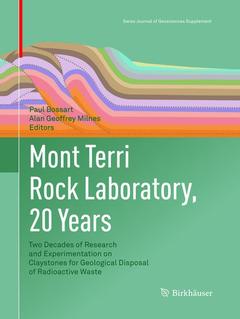Description
Mont Terri Rock Laboratory, 20 Years, 1st ed. 2018
Two Decades of Research and Experimentation on Claystones for Geological Disposal of Radioactive Waste
Swiss Journal of Geosciences Supplement Series, Vol. 5
Language: English
Publication date: 06-2019
422 p. · 21x27.9 cm · Paperback
Publication date: 01-2018
Support: Print on demand
Description
/li>Contents
/li>Comment
/li>
The international Mont Terri rock laboratory in Switzerland plays a central role in the safety and construction of deep geological nuclear repositories in clay formations. The laboratory has developed and refined a range of new measurement and evaluation methods: it has e.g. advanced the determination of rock parameters using innovative borehole geophysics, improved the methodology for characterizing pore-water and microbial activity in claystones, and greatly improved our understanding of diffusion and retention processes of radionuclides in and through claystones. The methods and insights described in this compendium can also be applied to low-permeability rocks at various sites around the globe, and in other fields of application.
Editorial: Mont Terri rock laboratory.- Mont Terri rock laboratory, 20 years of research: introduction, site characteristics and overview of experiments.- Litho- and biostratigraphy of the Opalinus Clay and bounding formations in the Mont Terri rock laboratory (Switzerland).- Tectonic evolution around the Mont Terri rock laboratory, northwestern Swiss Jura: constraints from kinematic forward modelling.- Tectonic structure of the “Main Fault” in the Opalinus Clay, Mont Terri rock laboratory (Switzerland).- Comparative study of methods to estimate hydraulic parameters in the hydraulically undisturbed Opalinus Clay (Switzerland).- Geochemical signature of paleofluids in microstructures from Main Fault in the Opalinus Clay of the Mont Terri rock laboratory, Switzerland.- Pore-water evolution and solute-transport mechanisms in Opalinus Clay at Mont Terri and Mont Russelin (Canton Jura, Switzerland).- Geomechanical behaviour of Opalinus Clay at multiple scales: results from Mont Terri rock laboratory (Switzerland).- Hydro-mechanical evolution of the EDZ as transport path for radionuclides and gas: insights from the Mont Terri rock laboratory (Switzerland).- Coupled hydraulic-mechanical simulation of seasonally induced processes in the Mont Terri rock laboratory (Switzerland).- High-resolution mini-seismic methods applied in the Mont Terri rock laboratory (Switzerland).- Seismotectonic analysis around the Mont Terri rock laboratory (Switzerland): a pilot study.- In-situ experiments on bentonite-based buffer and sealing materials at the Mont Terri rock laboratory (Switzerland).- Performance of the Opalinus Clay under thermal loading: experimental results from Mont Terri rock laboratory (Switzerland).- Implementation of the full-scale emplacement (FE) experiment at the Mont Terri rock laboratory.- 5-year chemico-physical evolution of concrete–claystone interfaces, Mont Terri rock laboratory (Switzerland).- Corrosion of carbon steel in clay environments relevant to radioactive waste geological disposals, Mont Terri rock laboratory (Switzerland).- Fifteen years of microbiological investigation in Opalinus Clay at the Mont Terri rock laboratory (Switzerland).- Impact of the electron donor on in situ microbial nitrate reduction in Opalinus Clay: results from the Mont Terri rock laboratory (Switzerland).- Natural gas extraction and artificial gas injection experiments in Opalinus Clay, Mont Terri rock laboratory (Switzerland).- Exploring diffusion and sorption processes at the Mont Terri rock laboratory (Switzerland): lessons learned from 20 years of field research.- Twenty years of research at the Mont Terri rock laboratory: what we have learnt.
Presents main results over 20 years of research in an underground rock laboratory in claystone
Well-illustrated examples of the different stages of repository evolution
The reader gets an excellent overview and never loses the common thread of the rather complex thematic
Contains invaluable data and information relevant to fundamental problems




